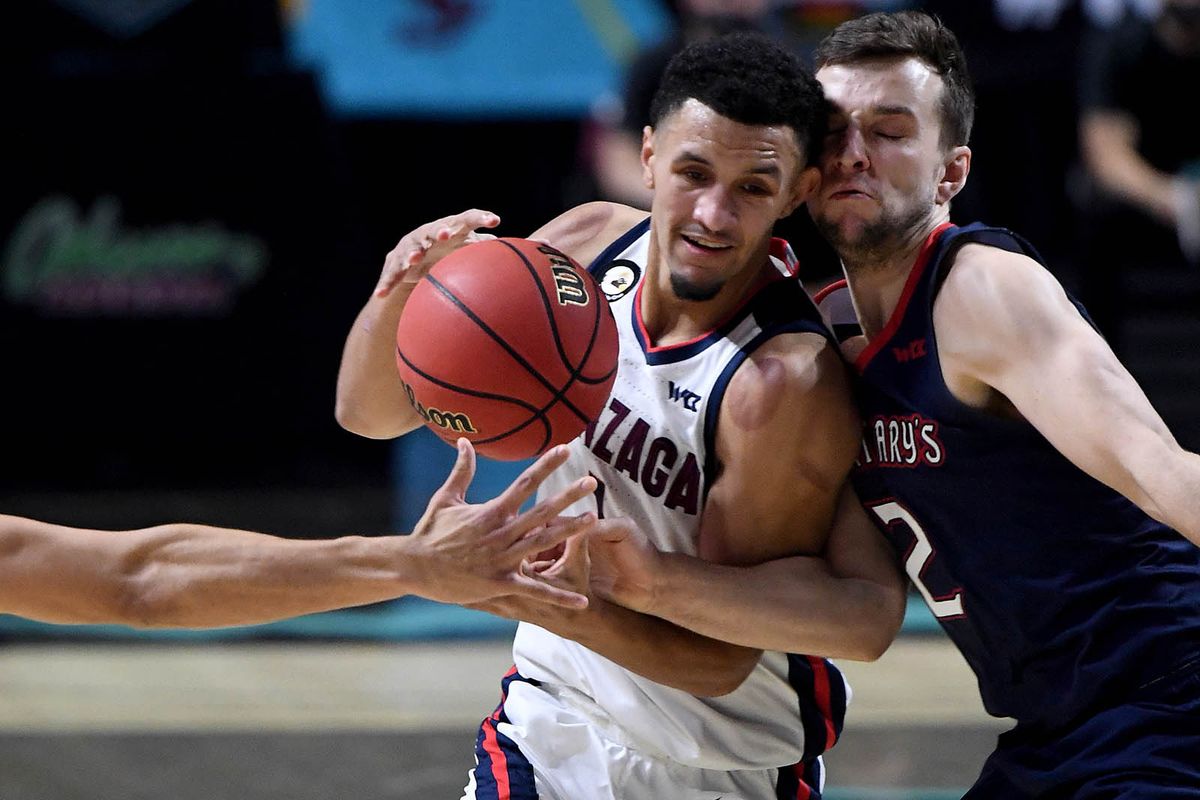TV Take: Familiar faces quick to defend latest March attack on Gonzaga’s flawless résumé

It sometimes seems the main ESPN pastime this time of year is to question Gonzaga’s résumé. No matter even, it seems, if the Bulldogs are perfect, at least by record, as they are in 2021.
Monday night, while the Zags were en route to a 78-55 West Coast Conference Tournament semifinal rout of fourth-seeded Saint Mary’s, it was Seth Greenberg’s turn to voice the doubts. But the duo who has seen them more in person than anyone at the network, Dave Flemming and Sean Farnham, were available to supply the rebuttal.
What they saw …
• Greenberg’s point, as the halftime studio crew tried to describe what could derail the 25-0 Zags’ national championship hopes, focused on Drew Timme. And the former Virginia Tech coach focused on one game, against West Virginia, quite possibly Timme’s least productive of this season.
Greenberg wondered if the sophomore can score against the bulky bigs Gonzaga may face in the loser-out tourney.
As soon as the broadcast came back to Las Vegas – or, if you prefer, to Flemming and Farnham in their homes – the world’s biggest Davenport Hotel fan began to defend the Gonzaga center.
“I have absolutely no concerns on whether or not Drew Timme can score in the NCAA Tournament,” Farnham said. “He’s got elite-level footwork. He’s got great balance. And, yes, the first half of the West Virginia game, he was bothered.
“He finished with 17 points, though. He had 15-9 (points and rebounds) against (Iowa center) Luka Garza. He had 25 versus Kansas. He had 29 versus Virginia. He can score against anybody.”
• Greenberg wasn’t the only person with whom Farnham disagreed during this one. He also had a couple of moments when he criticized referee Chris Rastatter, though he didn’t name the veteran official.
With 12 minutes, 51 seconds left to play, Jalen Suggs rose up and drove Dan Fotu’s floater off the backboard in a Sports- Center-worthy block. Except Rastatter - called it goaltending. As the replay rolled, Farnham succinctly said, “That was not goaltending.”
Six minutes later, Suggs was knocked down as he collided with Logan Johnson. Rastatter deemed it an offensive foul on the freshman point guard. As the replay rolled, Farnham succinctly said, “That was not a charge.”
• With less than a minute left in the first half, Timme did what he does. The 6-foot-10, 235-pound post sprinted down the court, found a spot on the block, took a quick pass, made a couple of moves and scored. It hit Flemming hard.
“How many times have we said this in this half?” the play-by-play man asked. “He runs the floor, he gets to that spot, they get him the ball, and you cannot stop him once that happens.”
What neither he nor Farnham mentioned is the reason, other than to praise Timme’s footwork, which is excellent. But one of the hallmarks of Mark Few’s program in the past decade or more is a practice emphasis on bigs running the floor. In fact, the Zags open practice with drills designed to improve just that.
And over the years, they have taken that practice into games better than anyone. Timme’s 7-for-7 start was testament to that. He led the Zags with 18 points, though all five starters reached double figures.

What we saw …
• Sometimes defense is all about the five players working in tandem, being better as a group than as individuals. That was important in this one, made that way by how deliberate Saint Mary’s (14-9) usually runs its offense.
But the game-opening 11-2 run, keyed by the Gaels’ seven consecutive misses, was a triumph of individual effort within the team concept. Saint Mary’s ran its offense, forcing switches at times. But it didn’t lead to good looks, because the Zags worked so hard to recover on their rotations.
The Gaels helped, of course, by failing to attack, especially off the high ball screen. Even when they did, though, there was a Bulldog in the way. It may have been their best stretch of defense this season.
Such efforts are why Gonzaga has improved its defensive efficiency rating throughout the season, reaching Ken Pomeroy’s top 10 late in the year. It is also how they can contend in the next tournament.
• No, we don’t know what the problem was. And we still don’t.
During a commercial break with 11 minutes, 20 seconds left in the first half, ESPN was running a promo. In the middle of it, Flemming’s voice, obviously intended for the producer, entered our living rooms.
“Do we know what the problem is?” we heard him ask. “No one is listening to me describe what the problem is. That’s all I’m trying to do, is say what’s going on.”
It was a conversation we weren’t supposed to hear. Luckily, Flemming followed one of the most important rules in live television: Never say anything with a mike in your face you’ll be embarrassed by if others hear.